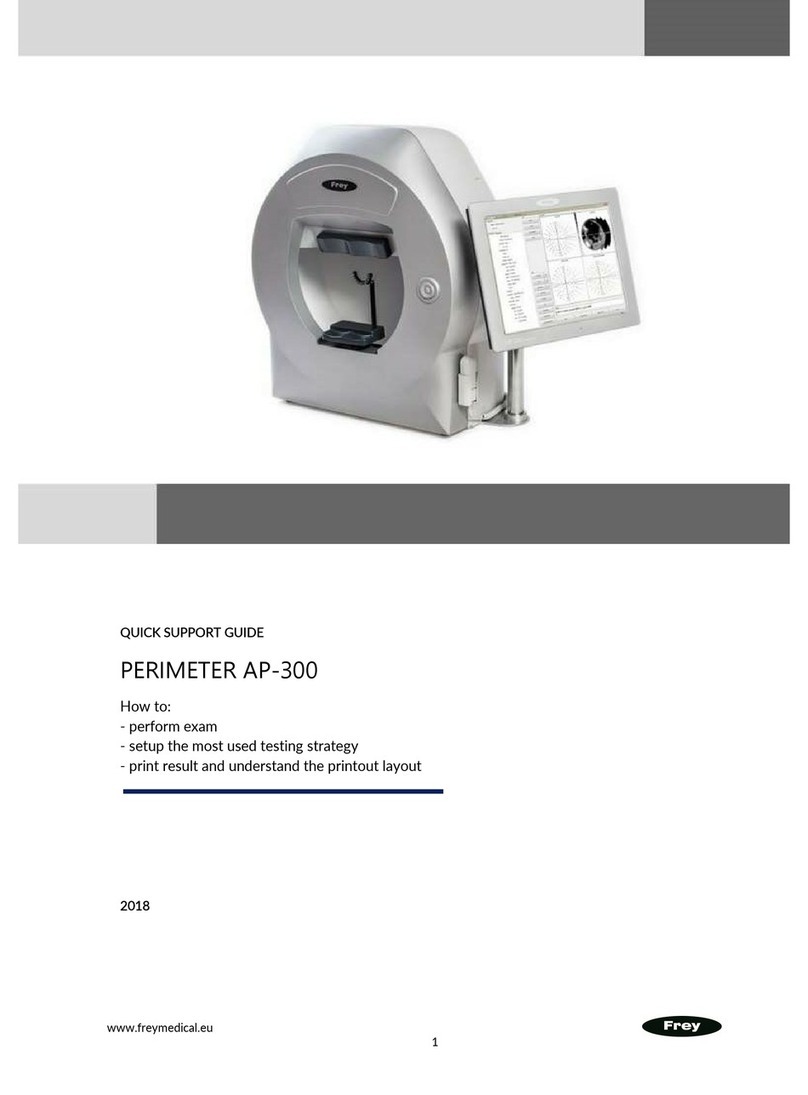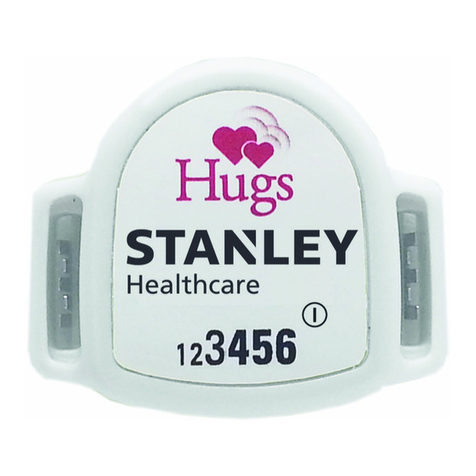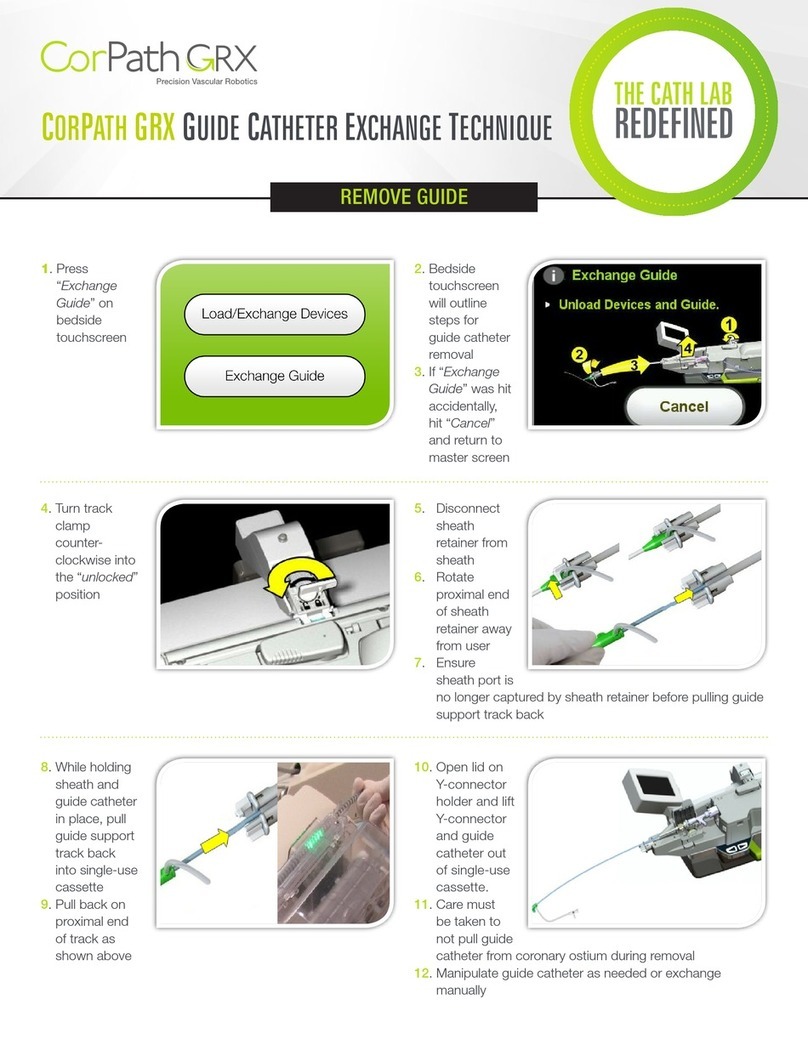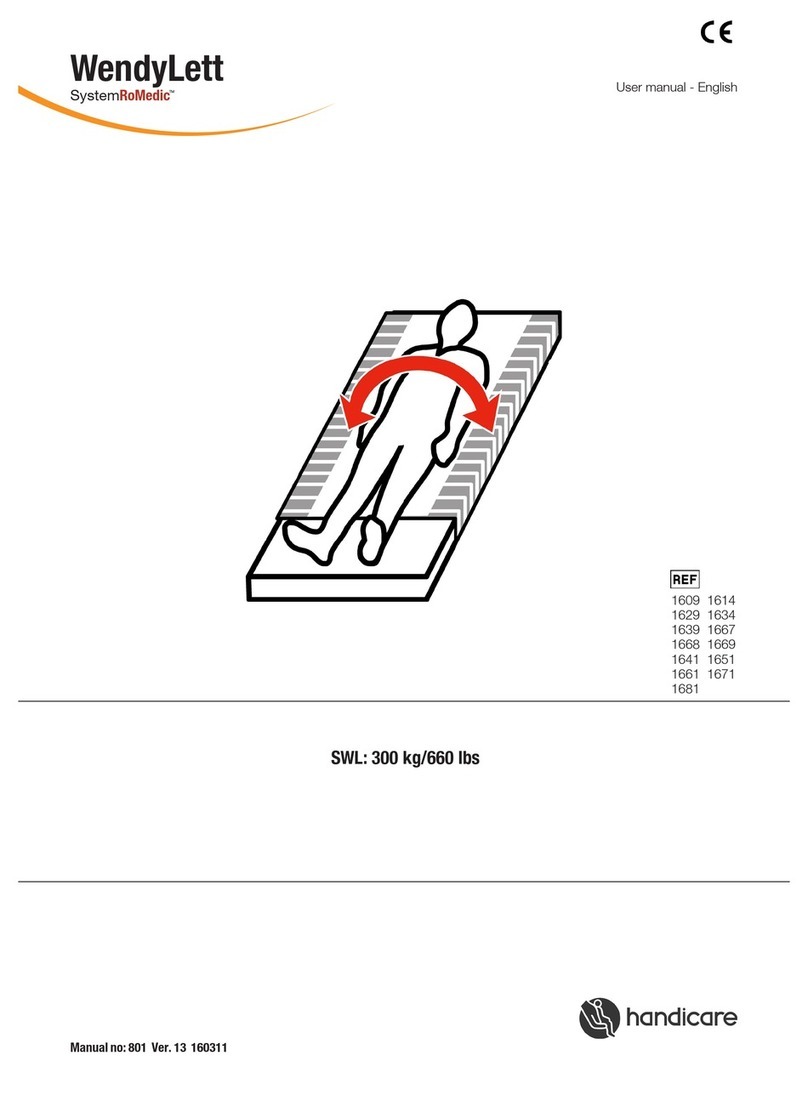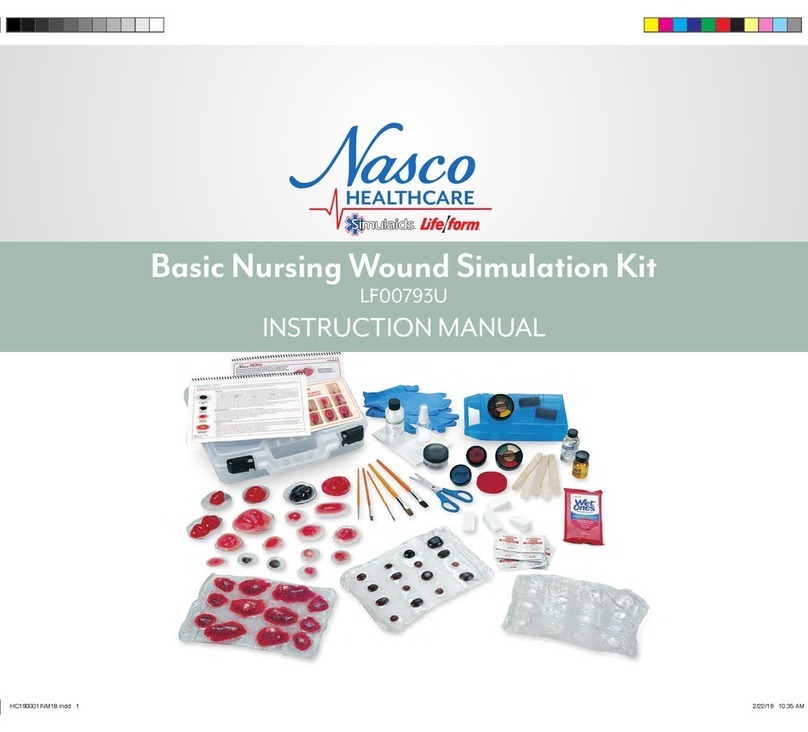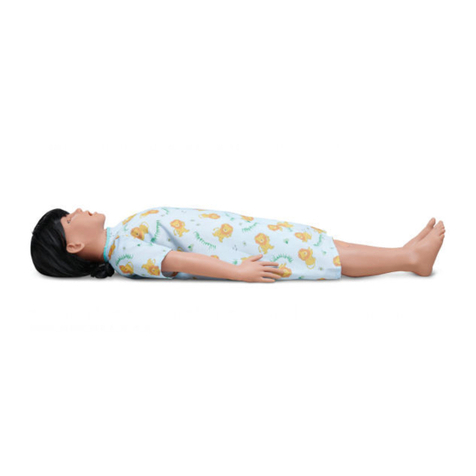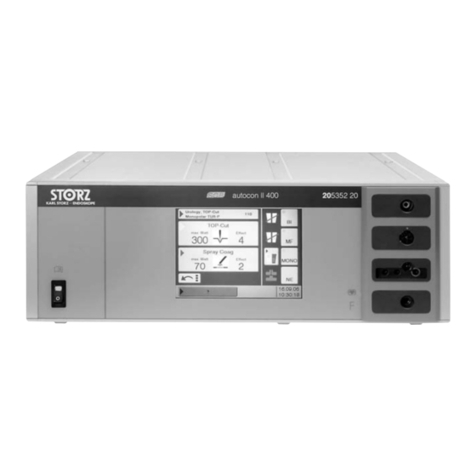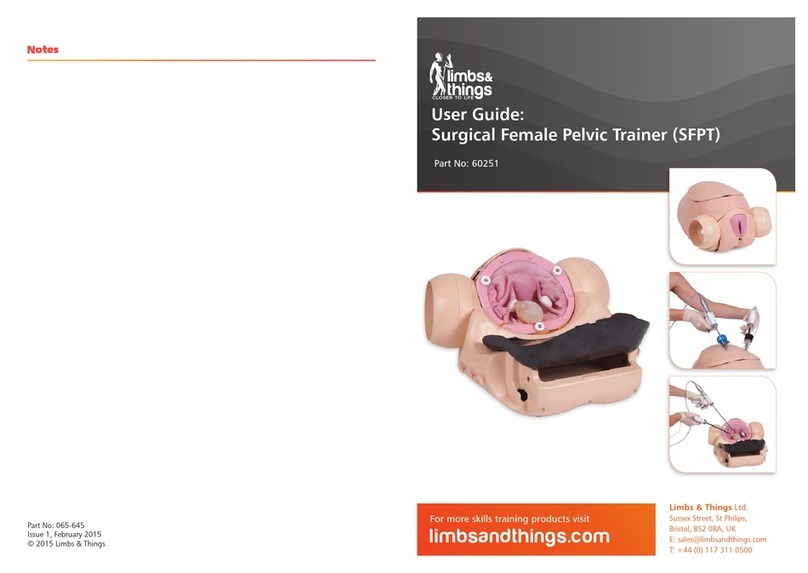Hellenbrand Hill-Rom Evolution LI156E Series User manual

User manual
Evolution™
LI156Ex
QD1532
A
Rev002

Information contained in this manual is subject to modification without notice
and implies no obligation on the part of Hill-Rom®. No part of this publication
may be reproduced, stored or transmitted in any form or by any means,
electronic, mechanical, photocopying, recording or otherwise, other than for
the user’s personal use, without the prior written permission of Hill-Rom®.
PLEASE NOTE
Persons depicted in the illustrations may be shown working in non-standard
working postures in certain situations, for reasons of clarity and visibility.
Not all the photographs used in this manual are contractually binding.
MANUFACTURER
Hill-Rom
B.P. 14 – Z.I. du Talhouët
56330 PLUVIGNER - FRANCE
Tel.: (33) 02 97 50 92 12
Fax: (33) 02 97 50 92 03
Version: February 2005

Evolution™ Electric Bed LI156Ex
QD1532A(2) 1
USER MANUAL
USE OF EVOLUTION LI156Ex BEDS
The EVOLUTION line of hospital beds includes acute care beds (with
mandatory Reverse Trendelenburg tilting) and general-purpose
variable height hospital beds for general care, for use in intensive or post-
operative care, in ICUs and General Medicine Wards. They can be used
both for intensive and non-intensive care and with the highly elaborate
techniques developed in special medical units. They are designed with the
needs of the whole medical team in mind and facilitate the use of ICU and
monitoring equipment and the transfer of patients to examination wards.
TABLE OF CONTENTS
0. INTRODUCING YOUR MODEL 3
1. SYMBOLS 5
1.1 GENERAL SYMBOLS 5
1.2 FUNCTION SYMBOLS 6
2. OVERVIEW 8
3. INSTALLING THE BED 9
3.1 FIRST STEPS 9
3.2 CONNECTION TO THE MAINS POWER SUPPLY 9
4. INSTRUCTIONS FOR USE 10
4.1 SIDERAILS 10
4.2 ELECTRICAL FUNCTIONS 12
4.3 ELECTRICAL FUNCTION LOCK-OUT 14
4.4 SLEEP SURFACE 15
4.5 HEAD SECTION 17
4.6 KNEE SECTION 20
4.7 BRAKE AND STEER SYSTEM 22
4.8 EQUIPOTENTIAL TERMINAL 23
4.9 SECURING THE POWER CORD 24
4.10 HEADBOARD AND FOOTBOARD REMOVAL 24
4.11 FRAME 25
4.12 RESTRAINING STRAP POSITIONS 26
4.13 FOOT END BED EXTENSION (optional) 26
4.14 LINEN HOLDER (optional) 27
4.15 BATTERY (optional) 27
4.16 HAND PENDANT CONTROL SOCKET (optional) 27
4.17 BEDSIDE CABINET TRANSPORT (optional) 28

Evolution™ Electric Bed LI156Ex
2 QD1532A(2)
USER MANUAL
4.18 LOCKOUT SWITCHES PROTECTION 29
5. ACCESSORIES 30
5.1 PATIENT HELPERS 30
5.2 VARIABLE HEIGHT I.V. POLE 33
5.3 END-BOARD FRAMES (AC930A) 35
5.4 BED EXTENSION PANEL (AC992A) 35
5.5 EQUIPOTENTIAL CABLE (AC968A) 36
5.6 HEADBOARD TRAY (AD083A) 36
5.7 HAND PENDANT CONTROL (AD091A) 37
5.8 BILATERAL VARIABLE HEIGHT FOOT PEDAL
(AD090A) 39
5.9 HAND PENDANT CONTROL SOCKET (AD089A) 39
5.10 SIDERAIL PROTECTIVE COVER (AD113A) 39
5.11 OXYGEN CYLINDER HOLDER
(AC959A-AD101A-AD102A) 40
5.12 ACCESSORY HOLDER 41
6. CLEANING 42
6.1 SAFETY RECOMMENDATIONS 42
6.2 GENERAL ADVICE 42
6.3 CLEANING AND DISINFECTING RECOMMENDATIONS 43
7. SAFETY TIPS AND PRECAUTIONS 45
7.1 SAFETY TIPS 45
7.2. MAINTENANCE 50
7.3. ABNORMAL USE 52
7.4. TRANSPORT AND STORAGE 53
7.5. DE-COMMISSIONING 53
8. SPECIFICATIONS 54
8.1. STANDARD FEATURES 54
8.2 DIMENSIONS 55
9. WARRANTY AND AFTER SALES SERVICE 56
10. STANDARDS COMPLIANCE 57

Evolution™ Electric Bed LI156Ex
QD1532A(2) 3
USER MANUAL
INTRODUCING YOUR MODEL
0. INTRODUCING YOUR MODEL
Version LI156Ex
Sleep surface dimensions 90 x 200 cm
Frame Laminated Hard surface Yes
Electrical function lock-out Yes
Adjustable bed-height Yes
Adjustable head Section Head Section “CPR” Yes
Comfort adjustment Yes
Adjustable knee section Power-driven with
Auto-contour Yes
Adjustable leg section Mechanical Yes
Integral siderails Yes
Central brake and steer system Yes
Castors Ø 150 Single band castors
OPTIONS
Trendelenburg / Reverse Trendelenburg (mandatory for acute care)
Integral bed extension
Integral linen holder
Additional control connections
Bilateral variable height foot pedal
Battery-driven operation
Cover for lock-out unit
Castors Ø 150 Double band castors
Ø 150 Antistatic double band castors
Ø 150 Antistatic single band castors
Ø 150 Complete castors
Ø 150 Antistatic complete castors
Directional castor at foot end of bed
Bedside cabinet transport

Evolution™ Electric Bed LI156Ex
4 QD1532A(2)
USER MANUAL
INTRODUCING YOUR MODEL
ACCESSORIES
AC907A : Raised urine holder
AC908A : 2 receptacle bottle holder
AC923A : Label holder
AC930A : Removable frame
AC932A : 3P 1L pivoting stainless steel bottle holder
AC938A : 3P 1L pivoting stainless steel bottle holder
AC953A : Chrome-plated I.V. hook
AC959A : Oxygen cylinder holder
AC961A : 3-litre bottle holder for frame
AC962A : 3-litre bottle holder for foot end
AC963A : Syringe-driver holder
AC967A : Monitor stand
AC968A : Equipotential cable
AC991A : Triangular section drainage holder
AC992A : Mattress for bedframe extension
AD016A : Semi-spherical drainage holder
AD080B : Chrome-plated patient helper
AD081C : Chrome-plated adjustable patient helper
AD082A : Stainless steel I.V. pole
AD083A*: Head-end tray
AD098A : Variable Height Electric pedal
AD090A : 3rd control connection
AD091A : 3rd control
AD113A : Siderail protective cover
AD165A : I.V. pole
*Incompatible with the bedside cabinet transport option

Evolution™ Electric Bed LI156Ex
QD1532A(2) 5
USER MANUAL
SYMBOLS
1. SYMBOLS
1.1 GENERAL SYMBOLS
Safety instructions: DO NOT BIN DO NOT PLACE ANYTHING
Please read Follow recycling on this surface
carefully procedure
Safety earth Equipotential terminal
Class II device Type B equipment
Direct current Alternating current

Evolution™ Electric Bed LI156Ex
6 QD1532A(2)
USER MANUAL
SYMBOLS
1.2 FUNCTION SYMBOLS
1.2.1 Manual controls
The following labels located next to the relevant control identify manual
operations.
Head Section “CPR” Trendelenburg/Reverse
Trendelenburg (option)
Adjustable Leg section
1.2.2 Brake and steer controls
Steer Neutral
STOP
Brake
1.2.3 Angle control
1.2.3.1 Bed without Bedside Cabinet Transport option
Reverse Trendelenburg
availability area Head Section Knee Section
1.2.3.2 Bed with Bedside Cabinet Transport option
Rev. Trend. and Bedside Cabinet
Transport availability area Head Section Knee Section
1.2.4 Electrical functionsNurse controls
Height adjustment Head sect. adjustment Knee sect. adjustment

Evolution™ Electric Bed LI156Ex
QD1532A(2) 7
USER MANUAL
SYMBOLS
Patient controls
Head Section adjustment Knee section adjustment
Lock-out panels
Electrical functions released Electrical functions locked out
Variable Height bilateral pedal (optional)
(accessory ref. AD098A)
Down Up
Hand pendant control (accessory ref. AD091A)
Head Section adjustment – Auto-
contour Knee Section adjustment

Evolution™ Electric Bed LI156Ex
8 QD1532A(2)
USER MANUAL
OVERVIEW
2. OVERVIEW
(*) option(*) option
Nurse siderail
controls:
Variable Height,
Head Section
and Knee
Section
Removable
headboard Head Section half-
length siderail. Patient siderail Head Section
and Knee Section control Leg Section half-length
siderail
Integral bed
extension (*)
Trendelenburg/
Reverse
Trendelenburg
control
(
*
)
Central brake and
steer pedal
Electrical
function lock-out
Leg Section control
handle.
Chassis
protecting cover
Battery (*)
2 accessory
holders
∅150 mm
castors
Siderail
positioning
handle
Head Section CPR
handle
Reinforced
corner post
I.V. pole and
patient helpe
r
sockets
Equipotential
terminal
Additional
accessory
holder zone Restraining strap
positions
Angle indicators
Headboard
holders and
power cord
hook
Horizontal symmetrical
headboard for
"bedside cabinet
transport" (*)
Hand pendant
control storage
and socket (*)
Bilateral Variable
Height foot pedal (*)
Identification
label

Evolution™ Electric Bed LI156Ex
QD1532A(2) 9
USER MANUAL
INSTALLING THE BED
3. INSTALLING THE BED
3.1 FIRST STEPS
Before using the bed, it is essential to have a thorough understanding of this
manual. It contains instructions for general use and maintenance and gives
you the assurance of improved safety.
Nursing staff must be informed of the risks encountered in the use of electric
beds.
The many sources and types of accessories, hardware or medical devices
that may be used jointly with this bed do not enable Hill-Rom to guarantee
both the safety and conformity of all the combinations thus created. The
operator who creates these device combinations must therefore ensure that
security and conformity requirements are met.
Before installing the bed for the first time or after bringing the bed and its
accessories out of storage:
- Ensure that the bed and its various parts are at room temperature
- Connect the bed to the mains power supply (see sect. 3.2 below)
- Ensure that all the moving parts are in good working order
- Ensure that the bed has been cleaned and disinfected (see chapter 6).
3.2 CONNECTION TO THE MAINS POWER SUPPLY
The mains power supply for the bed must comply with French standards NF
C 15-100 et NF C 15-211 (230V power point + earth) (France) and CEI 364
for other destinations.
Check that the power supply of the bed (identification label – sect. 2)
corresponds to the power supply voltage of the hospital.
The power supply should be equipped with a maximum 30 mA earth leakage
circuit breaker, in compliance with CEI 364-5-53.

Evolution™ Electric Bed LI156Ex
10 QD1532A(2)
USER MANUAL
INSTRUCTIONS FOR USE
4. INSTRUCTIONS FOR USE
4.1 SIDERAILS
The siderails are part of the frame. They rotate into position by moving
towards the head and foot of the bed in two stages (intermediate and fully
raised). When the siderails are lowered, the width of the bed is reduced.
When fully raised, the rails ensure patient protection and reduce the risk of
falls.
In the intermediate position, the rails can help a fully mobile patient get in
and out of bed safely and comfortably.
Nursing staff must decide which rail position is best suited to the patient’s
condition. With patients suffering from obsessive behavioural disorders,
for instance, it may be better to leave:
- the head section rails fully raised
- the leg section rails in either an intermediate position or lowered.
The Head Section rails should not be used in intermediate position if the
Head Section is raised by more than 30°.
1
2
3

Evolution™ Electric Bed LI156Ex
QD1532A(2) 11
USER MANUAL
INSTRUCTIONS FOR USE
Always ensure that there are no obstacles (patient’s limbs, objects,
accessories, etc.) before raising or lowering a siderail.
4.1.1 Raising a siderail
The siderails are located under the bed when not in use.
To raise a siderail:
- Pull the rail out from under the bed until fully extended
- Rotate the rail upwards into the required position (intermediate or fully
raised).
Ensure that the siderail
has clicked into
position.
4.1.2 Lowering a siderail
To lower a siderail:
- Hold the rounded end of rail firmly
- Pull the beige-coloured lever located
on the rail base
- Rotate the rail downward into the
required position (intermediate or
low)
- Release the lever
- When the rail is fully lowered, push it
back into position under the bed. 3
CLICK
2
1

Evolution™ Electric Bed LI156Ex
12 QD1532A(2)
USER MANUAL
INSTRUCTIONS FOR USE
4.2 ELECTRICAL FUNCTIONS
The power-driven features of the bed are controlled by panels located on the
inner and outer sides of the Head Section siderails (patient controls and
nurse controls respectively), by a bilateral variable height foot pedal
(optional) or by a hand-held unit (accessory).
4.2.1 Controls
4.2.1.1 Patient controls
Patients can use the controls located
on the inner side of the Head Section
rails to adjust:
- Head Section inclination and
Auto-contour if available (see
sect. 4.3)
- Knee Section Inclination.
PLEASE NOTE: The patient does not
have access to the bed
height adjustment
control.
4.2.1.2 Nurse controls
Nursing staff can use the controls
located on the outer side of the Head
Section rails to adjust:
-Bed height
-Head Section Inclination and
auto-contour if available (see
sect. 4.3)
-Knee Section Inclination.
PLEASE NOTE: Use of the nurse controls is reserved for nursing staff only.

Evolution™ Electric Bed LI156Ex
QD1532A(2) 13
USER MANUAL
INSTRUCTIONS FOR USE
4.2.1.3 Control identification
Controls are identified in several ways:
By colour:
-Light green arrow: Up
-Dark green arrow: Down
-Light brown (background): Patient controls
-Beige (background): Nurse controls.
By embossment:
-Raised arrows (only for upward movements and on the siderail
controls).
4.2.2 Bilateral variable height foot pedal (optional).
This pedal is located centrally under
the bed chassis.
Nursing staff can use this pedal to
adjust bed height while keeping their
hands free to deal with the patient.
Do not fit accessory AD011A to a LI156Dx or LI156Ex bed (see
identification label) that features this option. This accessory may trap or
damage the pedal and result in uncontrolled (undesirable) movements.
Raised arrows Light green
Beige
Dark green
Dark brown

Evolution™ Electric Bed LI156Ex
14 QD1532A(2)
USER MANUAL
INSTRUCTIONS FOR USE
4.3 ELECTRICAL FUNCTION LOCK-OUT
See Safety – General precautions for use, section 7.1
The electrical function lock-out panel can
be used to lock out or to release the
three power-driven functions either singly
or simultaneously.
Once a function is locked out, it can no
longer be operated using the siderail
controls, variable height pedal or hand
pendant control.
Controls released
Controls locked out
To lock out an electrical function:
- Switch the relevant control switch to lock: .
To release an electrical function:
- Switch the relevant control switch to unlock: .
IMPORTANT: Locking out the Knee Section adjustment control will also
lock out the Auto-contour feature (see sect. 4.5.3.).
Locking out the height adjustment control will also lock out the Reverse
Trendelenburg option when the bed is in a raised position.
Locking out the Head Section does not lock out the Auto-contour Knee
Section.
When the patient is restrained by the straps, the electrical functions must
be locked out.

Evolution™ Electric Bed LI156Ex
QD1532A(2) 15
USER MANUAL
INSTRUCTIONS FOR USE
4.4 SLEEP SURFACE
4.4.1 Power-driven or
variable height adjustment
Sleep surface height can be adjusted
using the nurse controls, the hand
pendant control or the bilateral foot
pedal (optional).
Always ensure that there are no objects or children under the bed before
operating the sleep surface height adjustment control.
- Make sure that the bed and accessories (patient helper, I.V. pole, etc.)
cannot strike any fittings (light fittings, service shafts, etc.).
- Make sure that the patient's arms and legs do not jut out from the
sleep surface.
4.4.2 Variable Height bilateral pedal (option).
This pedal is located centrally under the
bed chassis.
Adjust the height of the sleep surface by:
- pressing your foot on the
corresponding control arrow.
The Variable Height pedal uses the same colours as for the siderail controls
(see section 4.2.1.3).
Do not fit accessory AD011A to a LI156Dx or LI156Ex bed (see
identification label) that features this option. This accessory may trap or
damage the pedal and result in uncontrolled (undesirable) movements.
Down Up

Evolution™ Electric Bed LI156Ex
16 QD1532A(2)
USER MANUAL
INSTRUCTIONS FOR USE
4.4.3 Trendelenburg/Reverse
Trendelenburg (Optional)
(mandatory for acute care)
The sleep surface may be tilted towards the head of the bed (Trendelenburg
tilt) or towards the foot of the bed (Reverse Trendelenburg tilt). Positions
may be indexed and pegged. Maximum tilt can be obtained when the sleep
surface is positioned within the limits found in the table on the next page.
To tilt the sleep surface:
- For the Bedside Cabinet
Transport option, release the
brakes, move the bed away
from the wall, then apply the
brakes
- Unlock the safety catch by
pulling the lever located behind
the footboard handle
- Tilt the sleep surface in the
position required
- Release the safety catch lever
- Hold the bed by the footboard
rail and tilt slightly until it locks
into position (a click is heard).
NOTE: Nursing staff are advised to keep the bed at mid-height when moving
patients: Trendelenburg/Reverse Trendelenburg tilting will then remain
possible even in the event of power failure or of the battery being flat.
Reverse Trendelenburg tilting is possible in the absence of a power supply
when the bed is positioned between low and mid-height (manual operation
as indicated on the yellow label located on the elevator arm.
Reverse Trendelenburg availablility zone
High position
Low position
Bedside cabinet
transport
Mid-position

Evolution™ Electric Bed LI156Ex
QD1532A(2) 17
USER MANUAL
INSTRUCTIONS FOR USE
Trendelenburg/Reverse Trendelenburg with or without power supply
(mains or battery)
Bed position:
high Bed position: low Bed position:
mid-height
Power on Trendelenburg
/ Reverse
Trendelenburg
possible
Raise bed to use
Trendelenburg /
Reverse
Trendelenburg
tilting
Trendelenburg
/ Reverse
Trendelenburg
possible
Power off
(mains and
battery)
Trendelenburg
possible Reverse
Trendelenburg
possible
Trendelenburg
/ Reverse
Trendelenburg
possible
* Raise the bed to obtain the possibility of Trendelenburg
Before using this feature, always ensure:
-That the bed extension (optional) is secured
-That there are no objects or children under the bed.
If the sleep surface is not flat and the patient is heavy or the bed has an air
or water mattress, this operation should be carried out by two people.
-Make sure that the bed and accessories (patient helper, I.V. pole, etc.)
cannot strike any fittings (light fittings, service shafts, etc.).
-Make sure that the patient's arms and legs do not jut out from the sleep
surface.
-The Trendelenburg/Reverse Trendelenburg function cannot be used when
transporting a bedside cabinet on the bed. The nursing staff must ensure
that the physiological state of the patient is compatible with these
movements.
4.5 HEAD SECTION
Ensure that there are no obstacles (patient’s limbs, power cables, objects
or accessories) before using this feature.
4.5.1 CPR release
The Head Section CPR
release is activated by
disabling the adjustment
drive in CPR emergency
situations. The release is
cushioned.

Evolution™ Electric Bed LI156Ex
18 QD1532A(2)
USER MANUAL
INSTRUCTIONS FOR USE
Use the two handles located under the Head
Section behind each symbol to operate the CPR
release.
To lower the Head Section:
- Release the Head Section by pulling the CPR handle with one hand
- Control the descent of the Head Section using your other hand as
necessary
NOTE: Due to the dampened motion and depending on the weight or
position of the patient, it may be necessary to initially push down on
the head section.
- Release the handle when the Head Section is horizontal.
The Head Section power drive is automatically re-enabled after the instant
release system has been activated, whatever the position of the Head
Section.
The "CPR emergency release" function is unavailable when transporting
the bedside cabinet on the bed. The nursing staff must ensure that the
physiological state of the patient is compatible with these movements.
4.5.2 Head Section control
or or or
Head Section adjustment can be activated by the patient / nurse controls or
by the hand pendant controls.
The "Up" button on the Head
Section adjustment control
activates the Auto-contour feature.
The Knee section adjustment
control should be locked out using
the lock-out panel if only the Head
Section height adjustment feature
is required.
NOTE: When using the Bedside Cabinet Transport function, lock out the
Head Section control. See precautions, section 4.17.
Table of contents
Popular Medical Equipment manuals by other brands

Hormone Health Network
Hormone Health Network FreeStyle Libre manual
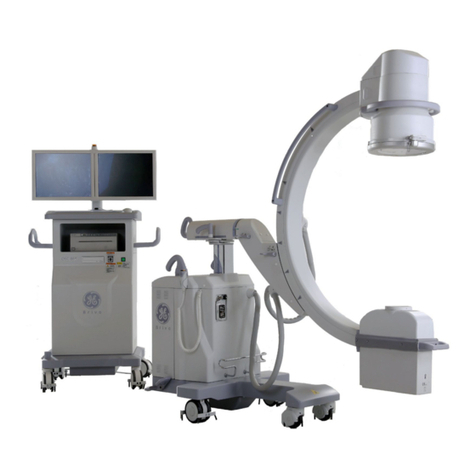
GE
GE Brivo OEC 715 Service manual
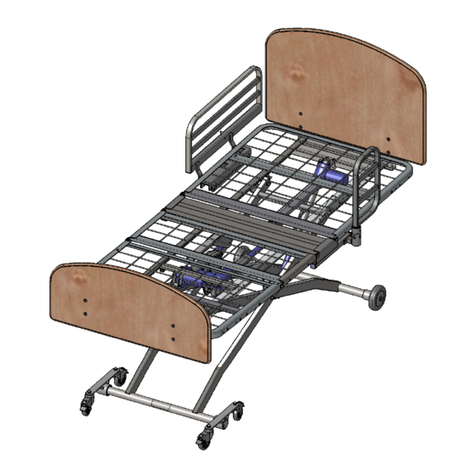
MPS
MPS M.C. Rexx QD2000 Series Use Care and Service Parts Manual
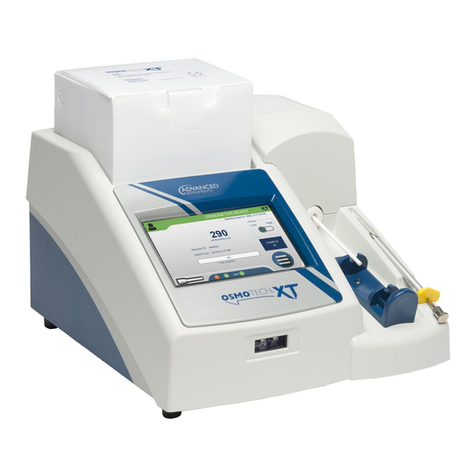
Advanced Instruments
Advanced Instruments OsmoTECH XT Service guide
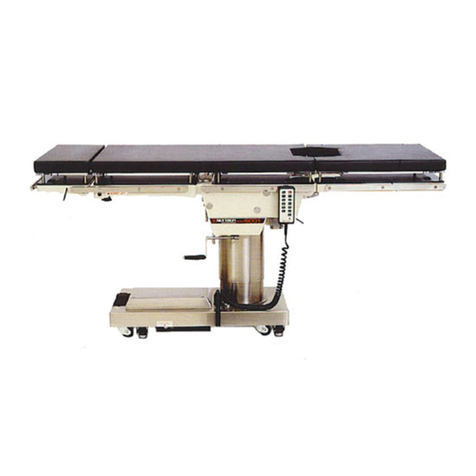
Skytron
Skytron ELITE 6000 Series Operator's manual
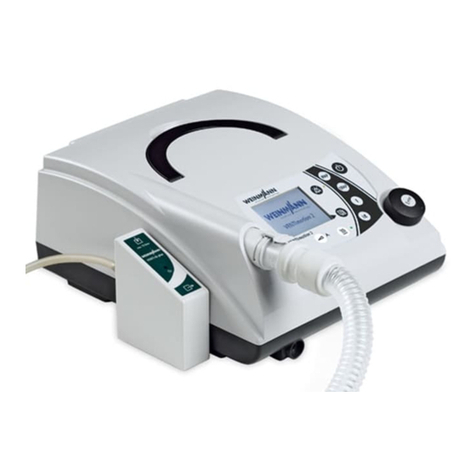
Weinmann
Weinmann VENTImotion Series Description of Unit and Operating Instructions for Patients
